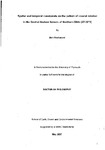Spatial and temporal constraints on the pattern of crustal rotation in the Central Andean forearc of Northern Chile (27-30°S)
| dc.contributor.author | Dashwood, Ben | |
| dc.contributor.other | Faculty of Science and Engineering | en_US |
| dc.date.accessioned | 2013-10-04T09:05:52Z | |
| dc.date.available | 2013-10-04T09:05:52Z | |
| dc.date.issued | 2007 | |
| dc.identifier | NOT AVAILABLE | en_US |
| dc.identifier.uri | http://hdl.handle.net/10026.1/2013 | |
| dc.description.abstract |
A total of 125 sites have been collected for palaeomagnetic analysis from two localities within the Coastal Cordillera and Precordillera regions of Northern Chile, between 27-30 °S, in addition to -200 samples collected from a magnetostratigraphic profile through the Pabellón Formation. In the southernmost (Tres Cruces) sampling locality, spanning the Coastal Cordillera- Precordillera boundary, the early, mid and latest Cretaceous-earliest Paleocene magmatic arcs intrude the earliest Cretaceous country rocks to the west and late Cretaceous rocks to the east. An ~50km transect sampled along Quebrada de Los Choros (~29°45'S), indicates that a consistent clockwise rotation of ~10°is recorded by primary magnetisations isolated from all of the units sampled, regardless of age, lithology or location. This is consistent with existing palaeomagnetic data immediately to the south, which has been recalculated, and suggests that localised rotations did not play a significant role in accommodating deformation at this latitude. Palaeomagnetic sampling of two plutons from the latest Cretaceous-earliest Paleocene magmatic arc situated in Quebrada de Los Choros and ~50km to the north, indicates that a sharp discontinuity exists in the regional rotation pattern, with the northern most pluton recording 30° of clockwise rotation. This discontinuity is observed to coincide with an area of diffuse deformation along which sinistral displacement is accommodated along predominantly NW orientated faults. This zone of deformation is interpreted as reflecting a pre-existing fundamental fault zone, similar in nature to a number of such NW striking crustal anisotropies that are observed to pre-determine much of the modern architecture of the modern forearc. These reactivated fault zones are interpreted to form the boundaries of large domains that display homogenous patterns of large magnitude clockwise rotation and are defined through a large number of palaeomagnetic studies. The age of rotation is not well defined in the Tres Cruces area, with a maximum age of 70-60Ma suggested for the youngest rotated plutons sampled, and the observation of a remagnetisation to the south. A second sampling area, situated in the Chilean Precordillera (c.27°45°S), was chosen to try and investigate the temporal accumulation of rotation in the northern Chilean forearc. A wide range of rocks of Triassic to Eocene age were sampled, albeit within the La Temera Fault System, associated with the Incaic orogeny, which marked the initial stages of the most recent phase of mountain building in the Andes. The oldest rocks record primary magnetisations that indicate ~40° of crustal rotation, very similar in magnitude to that recorded in the Coastal-Cordillera-Precordillera boundary zone to the west, suggesting that the La Temera Fault System does not control the regional rotation pattern. In addition, the youngest material sampled, a 40Ma pluton, suggests that rotation was completed prior to the Incaic orogeny, suggesting that crustal rotation in the present day forearc is not a consequence of plateau uplift or crustal thickening. | en_US |
| dc.language.iso | en | en_US |
| dc.publisher | University of Plymouth | en_US |
| dc.title | Spatial and temporal constraints on the pattern of crustal rotation in the Central Andean forearc of Northern Chile (27-30°S) | en_US |
| dc.type | Thesis | |
| plymouth.version | Full version | en_US |
| dc.identifier.doi | http://dx.doi.org/10.24382/4670 |
Files in this item
This item appears in the following Collection(s)
-
01 Research Theses Main Collection
Research Theses Main


